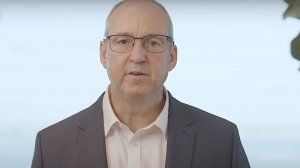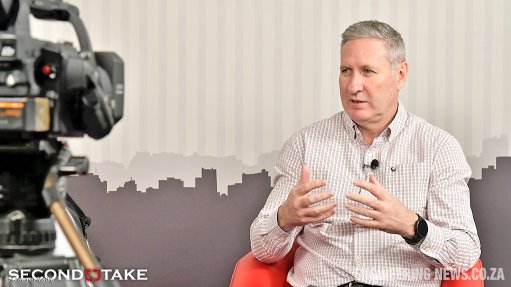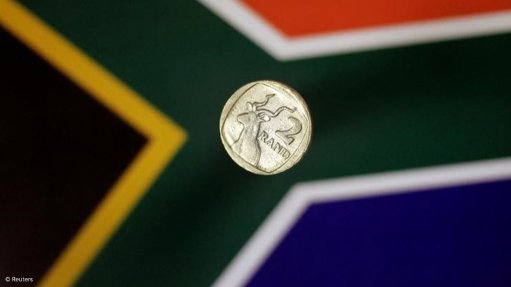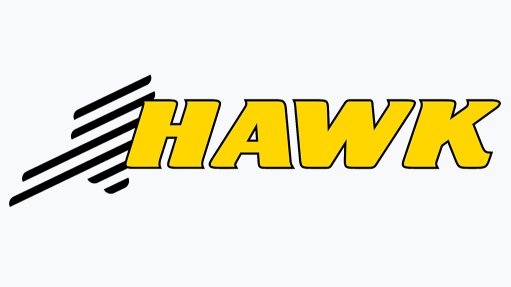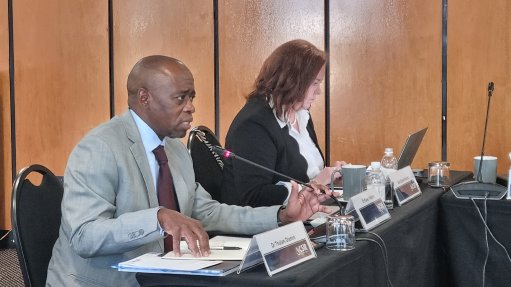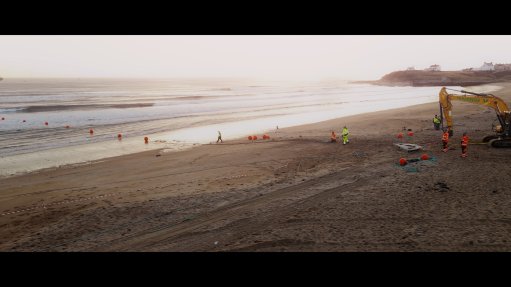South32’s future outlook has probably never looked brighter – CEO

South32 CEO Graham Kerr interviewed by Mining Weekly's Martin Creamer. Audio: Creamer Media's Shadwyn Dickinson.
The future outlook for South32, the mining and metals company spun out of BHP in 2015, has probably never looked brighter, says South32 CEO Graham Kerr.
“It’s a decade in for the company, and time goes super quick in that space, but what I’d say is the exposure we have to high-quality operations, with growth in copper, zinc and the aluminium value chain, strongly sets us up for the world’s transition to a low-carbon future,” Kerr outlined to Engineering News & Mining Weekly in an exclusive interview.
Accelerated low-carbon transformation has been a notable advance of the Johannesburg- and London-listed company, the operational Scope 1 and Scope 2 emissions of which decreased by 6% year-on-year and value chain Scope 3 emissions by 17% in the same period.
“One of the things we’ve really focused on, in the last three or four years, is the growth of our copper, zinc business, and the growth of our low-carbon aluminium business, because we think that’s going to play an important role in how the world decarbonises, the energy transformation.
In the next couple of years, we’ve got growth in copper of 15%, and 6% in 2025 and 2026. Low-carbon aluminium growth is 17%, and 8% for 2025 and 2026. Then we have a series of projects in the medium term, such as the fourth grinding line at Sierra Gorda, which is copper in Chile, the Taylor execution, which is zinc and potentially copper as well, in Arizona, US. We believe that positions us really well to go forward.
“With the sale of Illawarra Metallurgical Coal, we have a strong balance sheet which allows us to self-fund all those growth options while we’re rewarding shareholders, like we’ve done recently by starting our own market buyback again, with a board-approved $200-million.
So, from my perspective, it’s probably never looked brighter in terms of the future outlook,” Kerr posited.
South32’s financial results for the 2024 financial year were bolstered by an improved operating performance, cost management and higher prices for its key commodities in the latter half, which resulted in full-year underlying earnings before interest, taxes, depreciation and amortisation of $1.8-billion and underlying earnings of $380-million.
South African manganese production increased by 3% to a record 2.2-million wet metric tonnes in the year, and is expected to be two-million wet metric tonnes across full-year 2025 and full-year 2026, as South32 continues to use higher-cost trucking to optimise sales volumes and margins.
On the aluminium front, at Hillside in South Africa, a further 18% of pots were converted to AP3XLE technology, bringing the total to 36%. AP3XLE provides volume and efficiency benefits while reducing carbon intensity.
As aluminium produced at Hillside finds its way into European markets, making the operation greener to get around the Carbon Border Adjustment Mechanism (CBAM) is crucial.
Hillside supports more than 31 000 jobs directly and indirectly and contributes close to R10-billion to South Africa’s GDP.
South32 has two other aluminium smelters – Mozal in Mozambique, and the restarting Alumar in Brazil, but both of these are powered by hydro, which gives the aluminium produced by them vital green credentials.
Engineering News & Mining Weekly: How far is South32 from arriving at a decision on a power solution for Hillside Aluminium in Richards Bay?
Kerr: What we’re working on with the South African government at the moment is to try and find a way to get Hillside to a low- carbon aluminium smelter as well. Internally, we have a target to halve our Scope 1 and Scope 2 emissions by 2035, of which the biggest generator of our Scope 2 emissions is actually Hillside. We’ve been working in that space with Eskom and the South African government on the possibility of adding more and more renewables. We’re looked at it individually and just went out with a big request for information – RFI – recently. The positive news was the cost of solar and wind has dramatically come down and economically makes a lot of sense. The challenge for the smelter is that it needs power when there’s no wind and there’s no sun, which means, therefore, you rely on Eskom to provide the firming power, and that’s not a very economical solution for us or Eskom when that power’s in reserve. So, what we’re trying to work on now with Eskom is how do some of those renewables, wind, solar and the current nuclear allocation, feed into the broader network to ensure the long-term sustainability of Hillside. Now, we’ve got a bit of time to get this right. The current power contract finishes in 2031, but we, in public disclosures, have talked about halving our emissions by 2035. So, roughly, we’ve got 11 years to get this right, but we’re super invested because we think Hillside is an important part of South Africa’s economy, is very important from a social and labour and jobs perspective, and certainly is a world-class smelter that has many decades of operation ahead.
Have any new steps been taken towards the production by South32 of manganese sulphate for supply to the battery makers of battery electric vehicles?
Great question, and that is a piece of technology that is shifting, where people are exploring more and more about using manganese in EV batteries, and that’s driven by the density, charge, the costs, the durability, etcetera. We have two producing mines, one at Gemco in Australia that’s currently been impacted by a cyclone, and the other in the Kalahari, which is the world’s largest basin of manganese. One of the challenges in South Africa is, while the cost of production in terms of labour and equipment etcetera is competitive, there’s a long distance from the mines to the port, and a long distance from the port to the customer. Our focus in the short term in the Kalahari is on getting that transportation train to be as effective and as efficient as it can be, so we’re working with Transnet and also doing some of our own enhancements around capital expenditure to get our utilisation up.
Article Enquiry
Email Article
Save Article
Feedback
To advertise email advertising@creamermedia.co.za or click here
Comments
Press Office
Announcements
What's On
Subscribe to improve your user experience...
Option 1 (equivalent of R125 a month):
Receive a weekly copy of Creamer Media's Engineering News & Mining Weekly magazine
(print copy for those in South Africa and e-magazine for those outside of South Africa)
Receive daily email newsletters
Access to full search results
Access archive of magazine back copies
Access to Projects in Progress
Access to ONE Research Report of your choice in PDF format
Option 2 (equivalent of R375 a month):
All benefits from Option 1
PLUS
Access to Creamer Media's Research Channel Africa for ALL Research Reports, in PDF format, on various industrial and mining sectors
including Electricity; Water; Energy Transition; Hydrogen; Roads, Rail and Ports; Coal; Gold; Platinum; Battery Metals; etc.
Already a subscriber?
Forgotten your password?
Receive weekly copy of Creamer Media's Engineering News & Mining Weekly magazine (print copy for those in South Africa and e-magazine for those outside of South Africa)
➕
Recieve daily email newsletters
➕
Access to full search results
➕
Access archive of magazine back copies
➕
Access to Projects in Progress
➕
Access to ONE Research Report of your choice in PDF format
RESEARCH CHANNEL AFRICA
R4500 (equivalent of R375 a month)
SUBSCRIBEAll benefits from Option 1
➕
Access to Creamer Media's Research Channel Africa for ALL Research Reports on various industrial and mining sectors, in PDF format, including on:
Electricity
➕
Water
➕
Energy Transition
➕
Hydrogen
➕
Roads, Rail and Ports
➕
Coal
➕
Gold
➕
Platinum
➕
Battery Metals
➕
etc.
Receive all benefits from Option 1 or Option 2 delivered to numerous people at your company
➕
Multiple User names and Passwords for simultaneous log-ins
➕
Intranet integration access to all in your organisation


